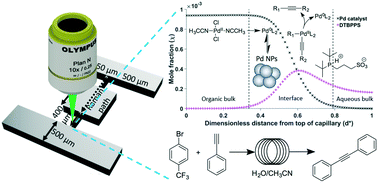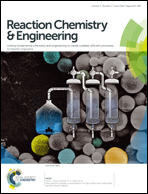Catalytic activity of Pd/hydrophilic phosphine ligand in the interface of an aqueous-phase Cu-free Sonogashira coupling†‡
Abstract
A Cu-free Sonogashira coupling was carried out in a microfluidic reactor with a static organic–aqueous interface and analyzed via in situ Raman spectroscopy. This was the first time that Raman spectroscopy was used in this way to analyze an active cross-coupling. This yielded a better understanding of the reactive interface-mainly that the Pd catalyst is only active in the mixture domain, either the cationic or the anionic deprotonation mechanism describes the reaction, and dissociation of the vinyl–PdII complex is potentially the rate determining step. The ratio of Pd to hydrophilic ligand is also non-stoichiometric as inactive stable Pd nanoparticles form. This validated previous kinetic models and the assumption that cross-couplings using a hydrophilic ligand can be described by thin film theory. Our findings support that the reaction should be performed with the minimal possible film thickness, which has implications on the design of the reactor. Characterization of the Pd and ligand within the interface is important for deriving accurate kinetic models that maximize catalyst recovery and selectivity while minimizing the environmental impacts of useful compounds when performing green chemistry.



 Please wait while we load your content...
Please wait while we load your content...